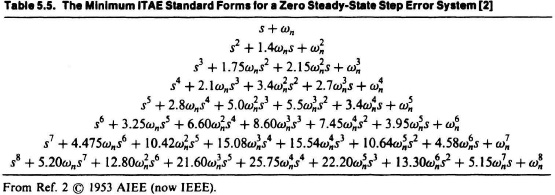5.9. OTHER PRACTICAL CONSIDERATIONS
The control engineer must be concerned with several other practical aspects before becoming able to state intelligently and completely the expected system performance. The concluding section of this chapter quantitatively discusses considerations of feedback system bandwidth, nonlinearities, size, weight, power consumption, and economics. Hopefully, this will aid in giving the reader a complete overall view of the problem.
Feedback system bandwidth is usually defined as the frequency at which the open-loop magnitude equals unity. Sometimes it is defined where it is −3 dB. The bandwidth of a system is indicated by its particular application. Usually, the control engineer is interested in designing the system to respond to a certain spectrum of input signal frequencies and to suppress all inputs above a certain frequency. It is important to emphasize that we should not arbitrarily design for a large bandwidth. Although large bandwidths usually result in large error constants, with small resulting system error, they also result in a system that responds to extraneous noise inputs and has considerable jitter due to the noise. The desirable approach is to design the feedback system bandwidth to be just large enough to pass the desired input-signal frequency spectrum and them attenuate all higher-frequency signals [4], Feedback system bandwidth considerations are discussed in detail in Chapters 6, 7 and 8, where methods for obtaining the frequency response are presented.
Nonlinearities are other factors that affect the performance of a control system. Primary concern is with backlash, stiction (starting friction) and Coulomb friction. Backlash, which was described in Section 5.3, is the amount of free motion of one gear while its mating gear is held fast. Stiction is the frictional force that prevents motion until the driving force exceeds some minimum value. Coulomb friction is a constant frictional drag that opposes motion, but has a magnitude that is independent of velocity. Each of these nonlinearities has an effect on performance. More will be said regarding nonlinearities in Chapter 5 of the accompanying volume.
Other factors of concern are size, weight, power consumption, and economics. The system must conform to certain specifications of size and weight. These are very important factors that usually dictate the design of the system. For example, these specifications may decide the type of power drive to be used. Power is another very important consideration. The system must usually perform within a certain allowable power limitation. Size, weight, and power consumption are usually very critical items for airborne and space applications. Last, but not least, is the question of economics. A basic fact of life is that most engineers work for organizations whose primary purpose is to make profit. Systems must therefore be designed as inexpensively as possible within the framework of good performance. A generally useful rule of thumb is that minimum-bandwidth systems will consume the least power and be the most economical.


